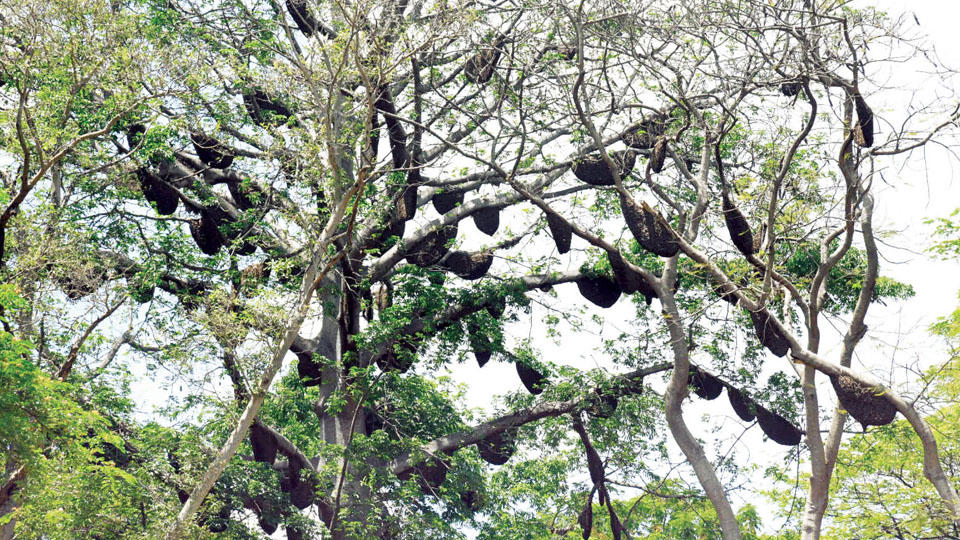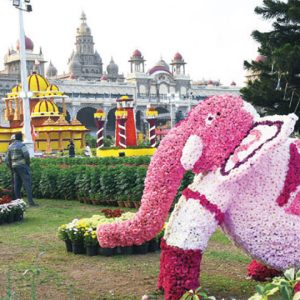Hundreds of honeybee colonies have once again migrated to Mysuru from an unknown location, building more than 150 hives on a single tree and beginning their reproduction process — a spectacle that continues to amaze onlookers.
For decades, these honeybee colonies have followed a remarkable migratory pattern: Arriving from an unidentified place every year, nesting on the same tree, staying for about four to five months, and returning to their original habitat as the seasons change.
Situated within the park maintained by the Horticulture Department — stretching from Jayachamaraja Wadiyar Circle (Hardinge Circle) to Mirza Road — stands a majestic 50-foot-tall cottonwood tree (commonly known as the kapok tree, Ceiba pentandra) with a wide canopy.
This tree has become a preferred breeding ground for honeybees year after year, offering them a secure habitat and leaving locals in awe of nature’s consistency and wonder.

A legacy tree for bees
Despite the presence of several other trees in the nursery, the bees instinctively return to the same cottonwood tree their ancestors chose decades ago. Experts believe this demonstrates the bees’ exceptional memory and navigational abilities.
This year, more than 150 hives cover the cottonwood tree. Additionally, over ten new hives have been built by newly formed colonies on two nearby trees, further reinforcing the tree’s appeal as a preferred nesting site.
Timing the bloom
Bee migration typically begins around the second week of December, coinciding with the blooming season to ensure a steady food supply. However, this year’s migration occurred later — in the last week of February — likely due to changes in weather patterns.
At present, Mysuru’s lush and varied flora is in full bloom, offering abundant nectar and pollen for the bees. As the monsoon arrives and heavy rains hit the city, many bee colonies vacate their hives, while some remain until the rainy season ends. Remarkably, about 10 to 15 hives continue to occupy the tree year-round.

A safe haven
There are several reasons why the cottonwood tree has remained a consistent choice for the bees. The location offers a safe and undisturbed environment for reproduction. Even during strong winds, the hives remain intact.
Ample water, abundant flora and the absence of human interference have made this site an ideal and reliable habitat for decades.
While many marvel at the natural spectacle, some residents in nearby homes have raised concerns. Although the bees have not stung anyone, their foraging behaviour leaves black stains on walls and yellow marks on freshly washed clothes, creating frustration among locals.
Every year, some people attempt to extract honey from these hives. However, the horticulture staff strictly prohibit such actions to protect both the bees and their nests. Attempts to harvest honey have been consistently thwarted, ensuring the safety of this fragile ecosystem.

A bond with bees
Over the years, the nursery staff have developed a quiet understanding of the bees. Although staff members have been stung a few times, they never retaliate. Their peaceful coexistence has prevented any major incidents, fostering mutual respect between humans and bees.
Despite their vital role in pollination and food production, bees often face threats when they build hives on human properties. In many places, people resort to harmful methods — like chemical sprays or fire — to remove hives, actions that are both dangerous and illegal, says Pradeep, a wildlife conservationist.
Fortunately, Mysuru has taken a more responsible approach, focusing on the safe relocation of beehives rather than their destruction. Protecting bees is crucial for preserving biodiversity and ensuring the balance of the ecosystem.








Recent Comments